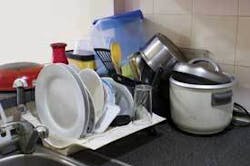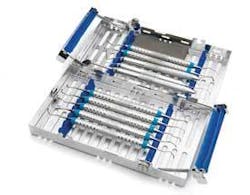Enhancing Efficiency and Productivity Through Instrument Management
Cassettes are a valuable investment in streamlining procedures that are vital to patient flow in a dental practice. The ultimate beneficiaries of this enhanced efficiency are the patients to whom you can dedicate more time and attention.
by Mary Govoni, CDA, RDH, MBA
Nothing takes the wind out of your sails on a busy day like not having the right instruments available when you need them. Instrument management is a vital component of every type of efficient, productive dental practice. But the ability to recirculate instruments quickly and easily for the doctor’s and hygienist’s patients is an often overlooked factor that affects production. We tend to take the instruments and processing for granted, until those instruments aren’t available when we need them.
Supply and Demand
Before we discuss the efficiencies of instrument management, however, we must first assess whether the supply of instruments is adequate to serve the needs of the practice. For general and most specialty practices, a good rule of thumb is to have enough procedure setups for a half-day’s patients. This number can be determined by averaging the number of procedures per day over several weeks. In orthodontic practices, where the volume of patients is much higher, the number of instrument setups should be adequate for one-quarter of a typical day. If your practice doesn’t have a good supply of instruments, invest in more setups to improve your efficiency. If enough setups are available, the clinical assistants can spend less time processing instruments and more time with patients. Next, consider investing in an instrument management or cassette system.
Efficiency and Ergonomics
Individual dental practices don’t usually have a team member dedicated to instrument processing. All of the steps involved in breaking down trays, cleaning, rinsing, drying, and packaging instruments for sterilization take precious time away from patients. As an increasing number of states allow dental assistants to perform expanded functions, their time is best utilized in the treatment room, rather than in the sterilization area. As a consultant, I frequently observe clinical team members struggling to keep up with instrument processing between patients. Making this process as efficient as possible assures that patient flow will not be interrupted and the assistants’ and hygienists’ time is best used treating patients and producing revenue for the practice.
My goal is to encourage readers to evaluate their instrument management and processing systems with a critical eye toward efficiency and ergonomics. Think about the number of steps required to set up your treatment rooms, transport instruments to the processing area, and the time spent cleaning and sterilizing. The fewer movements required, the greater the efficiency and ergonomics.
Start with treatment room setup. With a cassette, all of the instruments for a procedure are stored in one cassette, requiring retrieval of only one item. The cassette is opened and the instruments are ready to use, since the cassette serves as the tray or delivery system. Without cassettes, one or more packages of instruments must be retrieved, opened, and set up on a tray or delivery system for use. Although the time efficiency here is more subtle than in the cleaning and sterilizing process, cassettes do make treatment room setup more efficient. An example is in how the instruments are arranged in the cassette - in sequence of use. If an instrument is missing from the setup, it is very noticeable. It is a little more difficult to see this when looking at a pack of instruments. Since the instruments for a given procedure stay in the cassette at all times, except when in use, it is very unlikely that the setups will have missing instruments. As we all know, if a missing instrument is discovered in the middle of treatment, workflow is interrupted. Either the assistant has to leave the room to get the missing instrument or must call someone to bring it to the treatment room.
Cleaning and Sterilization
The value of instrument cassettes is most clear when it is time to clean and sterilize the instruments. The clinical team removes any disposable items from the cassette either in the treatment room or in the sterilization area. The cassette is closed and placed in an ultrasonic cleaner or in an instrument washer. Without a cassette, the instruments must be handled individually or in groups for placement into the ultrasonic unit. Not only is this more time-consuming, but it poses a safety hazard to the clinical team member who is handling the contaminated instruments. Cassettes help fulfill the OSHA requirement for transporting contaminated sharp items in closed containers.
After the instruments are cleaned, they are rinsed, dried, packaged, and placed in the sterilizer. In a cassette, this process requires only one item (the cassette) to be handled per procedure setup. Without cassettes, the instruments must be sorted back into the appropriate groups, requiring more handling and more time. I have observed some teams bundling the instruments together as setups prior to placing them in the ultrasonic cleaner, but I don’t believe that it is a good idea. If the instruments are bundled very tightly together, the instrument handles may not be thoroughly cleaned, which may prevent them from being sterilized.
Labeling
Once the instruments are removed from the sterilizer, the cassettes or instrument packages are stored until needed. Cassettes can be labeled or color-coded by procedure, allowing for quick identification and retrieval from the storage area. For example, packaging tape with the name of the procedure preprinted on it can be used to seal the packaging material. Also, the inserts that hold the instruments come in a variety of colors, which can be linked to various procedures. In other instances, the entire cassette or instrument box can be color-coded according to procedure setup. In many cases, instrument packages are stacked in drawers, which may require slightly more time to sort through the packages to find the appropriate setup.
Cassettes Are A Valuable Investment
To sum it up, cassettes are a valuable investment in streamlining procedures that are vital to patient flow in a dental practice. The time and motion required to process the instruments are reduced, safety in handling is increased, and greater efficiency is gained in setting up treatment rooms. The ultimate beneficiaries of this enhanced efficiency are the patients to whom you can dedicate more time and attention.
About the Author
Mary Govoni, CDA, RDH, MBA, is the owner of Clinical Dynamics, a consulting company based in Michigan. She is a member of the Organization for Safety and Asepsis Procedures and is a featured speaker on the ADA Seminar Series. She also writes a column for Dental Office magazine. She can be contacted at [email protected].



